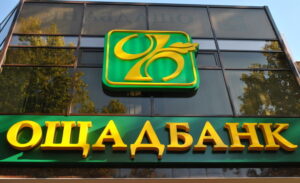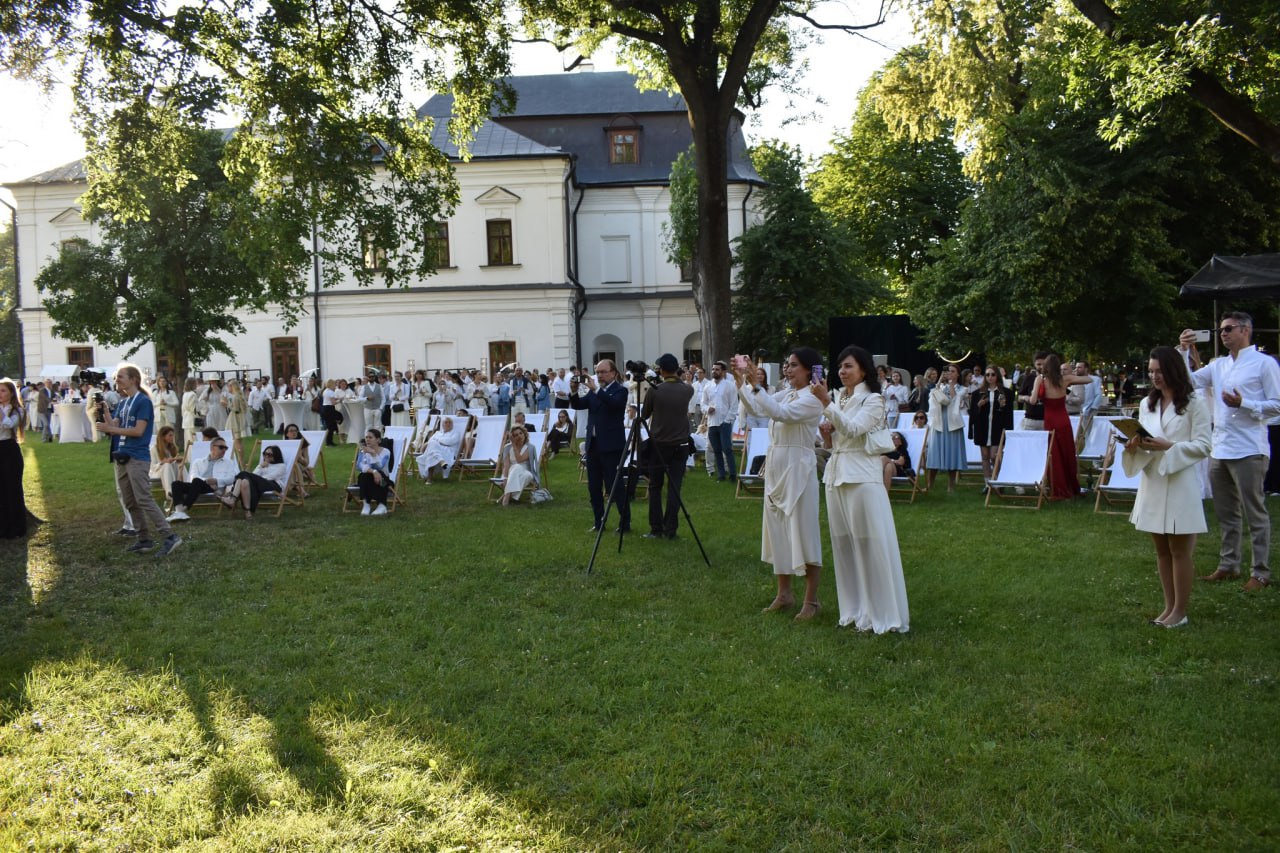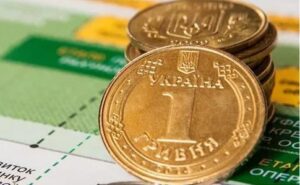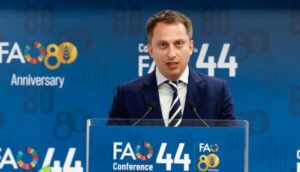
Oschadbank has signed an investment loan agreement worth EUR 10.8 million with Helios Strategia Group’s subsidiary, Elio Luchky LLC, to finance the construction of a solar power plant with an installed capacity of 22.35 MW, inverter capacity of 16 MW and an energy storage facility (ESF) with a capacity of 33.44 MWh.
According to the bank’s press release on Monday, the solar power plant and energy storage facility will be located in the Mukachevo district of Zakarpattia region, with commissioning scheduled for January 2026.
“Our agreement with Helios Luchky is a 7-year project financing deal. These are the same “long-term” funds for new construction that are needed for economic development. I am glad that more and more such investment projects are being implemented,” commented Yuriy Katsion, Deputy Chairman of the Management Board of Oschadbank, responsible for corporate business.
According to him, this project is significant in terms of combining technologies that will ensure maximum profitability when selling electricity on the day-ahead market.
In his opinion, this is a good example of a balanced approach to the development of the country’s decentralized energy system.
“This project is not only a step towards a new decentralized energy sector, but also a demonstration of the technological readiness of Ukrainian companies to implement complex infrastructure solutions. We are grateful to the Oschadbank team for their partnership and belief in high-quality projects for a new energy future,” said Olena Skrypnyk, founder of Helios Strategia.
The release states that the international engineering group Helios Strategia specializes in EPC projects for solar energy and the implementation of renewable energy solutions for the industrial and commercial sectors. The total capacity of solar power plant projects in which the group has participated reaches 1.2 GW. The group’s other facilities are located mainly in the Dnipropetrovsk region, as well as in the Odesa and Mykolaiv regions.
As reported at the end of June, according to Yevhen Myachyn, Director of the Corporate Business Development and Support Department at Oschadbank, since the beginning of 2025, the volume of energy loan agreements concluded by Oschadbank with corporate clients has increased to EUR93 million, of which approximately 45% are energy storage facilities (ESF), 43% are wind farms, and 12% are ESF together with solar power plants.

Ferrexpo plc, a mining company with its main assets in Ukraine, produced 2,169,631 tons of pellets in January-June this year, which is 34.2% less than in January-June last year (3,297,441 tons).
According to the company’s press release on Monday, total production of commercial products (pellets and iron ore concentrate) in the first half of 2025 decreased by 9% compared to the first half of 2024, to 3 million 393,135 thousand tons. In particular, the output of marketable concentrate amounted to 1 million 223.504 thousand tons against 429.865 thousand tons, respectively. The company also produced 81,787 thousand tons of DR pellets (in the first half of 2024 – 162,645 thousand tons) and 2 million 87,844 thousand tons of premium pellets (a decrease of 33.4%).
The press release notes that from January to April 2025, the amount of VAT refunds denied amounted to $31 million. Due to the current suspension of VAT refunds and the associated decline in financial liquidity, the group was forced to reduce production from two to one pelletizing line and also to reduce the production of high-quality concentrate. As a result, total commercial production for the second quarter amounted to 1.3 million tons, down 40% from 2.1 million tons in the first quarter.
However, the group demonstrated flexibility and agility by continuing to benefit from strong demand for its concentrate from customers in China, which accounted for more than a third of its product mix in the first two quarters of 2025, the statement said.
Among other things, it has made efforts to reduce its costs in order to remain financially viable. This includes reducing working hours for employees, cutting purchases of goods and services, and suspending all non-essential capital expenditures, overhead costs, and corporate social responsibility expenses.
Commenting on the group’s performance, interim CEO Lucio Genovese noted that the strong momentum at the beginning of the year, which reflects, in particular, increased quarterly production since the full-scale invasion in February 2022, was significantly limited in the second quarter as the company began to feel the impact of tax authorities’ decisions to suspend VAT refunds. As a result, production fell to 1.3 million tons in Q2 2025.
“Despite the weaker iron ore pellet market, we were able to significantly change our production portfolio and take advantage of strong demand in China for our high-quality low-alumina iron ore concentrates. During the first six months of 2025, concentrate sales accounted for 36% of our production portfolio, three times more than in the same period a year ago. In a challenging operating and market environment for iron ore, it is encouraging that we have been able to be so flexible and take advantage of the demand for high-quality concentrates,” said the top manager.
At the same time, he pointed out that lower iron ore prices and reduced production had a negative impact on profitability. The situation was exacerbated by higher prices for raw materials such as gas and electricity. During the second quarter, the group worked hard to reduce its costs in order to remain financially viable.
“This includes reducing working hours or leave for approximately 37% of employees, reducing purchases of goods and services, and suspending all non-essential capital expenditures, CSR, and humanitarian expenditures. At the same time, every effort is being made and measures are being taken with the relevant authorities and government agencies in Ukraine and internationally to try to resolve the issue of the suspension of VAT refunds,” Genovese added.
As reported, Ferrexpo produced 1 million 347,749 thousand tons of pellets in Q1-2025, which is 26% lower than in January-March last year (1 million 813,973 thousand tons). At the same time, total production of commercial products (pellets and iron ore concentrate) in Q1 2025 increased by 3% compared to Q1 2024, to 2 million 125.467 thousand tons. In particular, the output of marketable concentrate amounted to 777,718 thousand tons, compared to 240,516 thousand tons in Q1-2024. The company also produced 81,879 thousand tons of DR pellets (not produced in Q1-2024), 1 million 105.049 thousand tons of premium-grade pellets (a decrease of 36%) and 160.913 thousand tons of other pellets (an increase of 95%).
In 2024, Ferrexpo increased its production of pellets by 58% compared to 2023, to 6 million 70.541 thousand tons from 3 million 845.325 thousand tons. In the fourth quarter of 2024, it produced 1 million 503.373 thousand tons of pellets, which is 18% higher than in the previous quarter (1 million 269.727 thousand tons).
At the same time, total production of marketable products (pellets and iron ore concentrate) in 2024 increased by 66% compared to 2023, to 6 million 889.879 thousand tons from 4 million 152.028 thousand tons. In particular, the output of marketable concentrate reached 819,338 thousand tons compared to 306,703 thousand tons in 2023. The company also produced 489,720 thousand tons of DR pellets, 4 million 984,990 thousand tons of premium pellets, and 595,831 thousand tons of other pellets.
In 2023, Ferrexpo produced 3.845 million tons of pellets, which is 36.5% less than in 2022.
Ferrexpo owns 100% of Yeristovsky GOK LLC, 99.9% of Bilanivsky GOK LLC, and 100% of Poltavsky GOK PJSC.

On June 26, 2025, the National Conservation Area “St. Sophia of Kyiv” hosted the Festival of Music, organized by the French-Ukrainian Chamber of Commerce and Industry, to celebrate the beginning of summer, music and solidarity.
This holiday has been a mandatory French event since 1982.

This is the second time CCIFU and its partners have organized this event. But this time it was not only festive, but also charitable – all the funds raised in the amount of 35,000 euros will go to support
the National Rehabilitation Center “Unbreakable” (UNBROKEN Ukraine) in Lviv, namely its department for patients with spinal cord injuries.

The guests were treated to a real celebration of music: Svitlo Concer with a selection of French songs in a new sound, virtuoso performance by one of the best contemporary pianists Yevhen Khmara and the Ukrainian music band TVORCHI, whose performance captured the audience’s attention from the first seconds, creating an incredible atmosphere of drive and sincere emotions.
CCIFU, charity event, Khmara, Music Festival, St. Sophia of Kyiv

In July this year, almost 20,000 used passenger cars imported from abroad were added to the Ukrainian car fleet, which is 7% more than in the same month last year, according to UkrAvtoprom on its Telegram channel.
As reported, in April and May, this market showed positive dynamics compared to the same month last year, increasing by 14% to more than 22,000 units. That is, compared to May 2025, demand fell by 10% in June.
According to UkrAvtoprom, the average age of used cars registered in Ukraine last month was 8.8 years (in May – 9.3 years).
Gasoline cars traditionally account for the largest share of imported used cars, with a significant lead of 48%. Next, ahead of diesel cars, are electric cars with 23%, diesel cars with 21%, hybrids with 5%, and cars with LPG systems with 3%.
The Volkswagen Golf remains the clear leader in this segment of the car market with 985 registrations in June.
The top ten most popular models also include the Renault Megane (698 units), Skoda Octavia (652 units), VW Tiguan (64 units), Tesla Model Y (567 units), Audi Q5 (560 units), Nissan Rogue (520 units), Tesla Model 3 (513 units), Nissan Leaf (468 units), and VW Passat (451 units)., Nissan Leaf – 468 units, VW Passat – 451 units.
In total, according to the association, Ukrainians purchased 113,400 imported used cars in the first half of the year, which is slightly (0.1%) more than in the same period in 2024.
As reported, according to UkrAvtoprom, in 2024, demand for used foreign cars from abroad increased by 4% compared to 2023, to 222,100 units, which accounted for 75% of the passenger car market.
In turn, the automotive market research institute, analyzing the demand for used cars (imports plus domestic resales), notes on its website that in June 2025, service centers of the Ministry of Internal Affairs registered 71,300 purchase and sale agreements – 12.9% less than in May 2025 and 27.5% less than in June 2024.
Volkswagen also maintained its lead in this segment with a significant margin (8,682 thousand registrations), almost twice as much as its closest competitor BMW (4,129 thousand).
Next in the top ten are Renault, VAZ, and Skoda, which are almost equal to each other (and to BMW) in terms of volume, but are focused on different target groups: The list is rounded out by Audi, Toyota, Ford, Mercedes-Benz, and Hyundai — consistently popular brands that meet the needs of various segments: from budget to premium, from gasoline to hybrids.
Among the models, the most popular in June was the Volkswagen Passat (2,532 thousand units), slightly ahead of the Skoda Octavia (2,124 thousand), with the Volkswagen Golf, which is particularly popular in cities, in third place.
The average age of cars in the secondary resale segment was 15.7 years.
According to the institute, in June, demand for used cars (imports and domestic market) fell by 12% compared to May 2025, to 91,850 units.

Revenues from taxes, fees, and mandatory payments to the general and special funds of the state budget of Ukraine in the first half of 2025 amounted to UAH 1.87 trillion, while cash expenditures amounted to UAH 2.4 trillion, which is approximately 42% and 24% higher than the corresponding figures for the first half of 2024.
According to operational data from the State Treasury Service published by the Ministry of Finance on its website, revenues to the general fund increased by 43% to UAH 1.3 trillion, while expenditures increased by 21% to UAH 1.87 trillion.
It is noted that after raising the military tax from 1.5% to 5% and introducing a condition for reserving salaries at UAH 20,000 this year, personal income tax and military tax came in second place in terms of revenues for the first half of this year, amounting to UAH 167.8 billion compared to UAH 97.1 billion last year.
In addition, the main revenues were provided by: VAT on goods imported into the customs territory of Ukraine – UAH 245.3 billion (in the first half of 2024 – UAH 223.9 billion), VAT on goods produced in Ukraine – UAH 156.1 billion for reimbursement of UAH 86.2 billion (UAH 132.1 billion for reimbursement of UAH 70.1 billion), corporate income tax – UAH 155.7 billion (UAH 147.6 billion), excise tax – UAH 132.7 billion (UAH 91.1 billion).
In addition, dividends and part of the net profit of state-owned companies amounted to UAH 55.6 billion (UAH 64.2 billion), import and export duties – UAH 25.2 billion (UAH 23.8 billion), rent for the use of subsoil resources – UAH 18.8 billion (UAH 23.4 billion).
The Ministry of Finance added that another 84.2 billion UAH (38.6 billion UAH) was added to the budget from the National Bank’s profits.
According to the information, the ERA mechanism launched by the G7 at the end of last year to use revenues from frozen Russian assets significantly increased grant international aid revenues to the budget – to UAH 210.9 billion, compared to UAH 40.3 billion in the first half of 2024.
Revenues from the single social contribution to pension and social insurance funds in January-June 2025 increased by 23% to UAH 314.6 billion, including a 20% increase in June to UAH 57.4 billion.
The Ministry of Finance also reported that as part of the financing of the general fund of the state budget, state borrowings to it in January-June 2025 amounted to UAH 856.2 billion (UAH 746.9 billion), or 87.0% of the plan, including UAH 232.5 billion (UAH 242.4 billion) from the domestic market through the placement of government bonds, including UAH 44.7 billion (UAH 72.92 billion) in foreign currency – $642.0 million and EUR388.8 million ($1,149.5 million and EUR665.7 million).
At the same time, UAH 111.7 billion (UAH 164.2 billion) was raised through the issuance of military government bonds.
According to the release, about $15.0 billion ($12.8 billion) came from external sources, including about $11.0 billion under the ERA, with the total volume of this mechanism amounting to $50 billion.
In addition, Ukraine received another EUR3.1 billion from the EU under the Ukraine Facility preferential long-term loan, $0.44 billion from the IMF and $0.24 billion from the World Bank for the projects “Transforming Health Care through Reform and Investments in Efficiency” (THRIVE) and “Building Resilient Infrastructure in Vulnerable Environments in Ukraine” (DRIVE).
Payments on public debt in January-June 2025 amounted to UAH 322.4 billion (UAH 259.1 billion), or 97.6% of the plan, and service payments amounted to UAH 179.85 billion (UAH 132.8 billion), or 73.9% of the plan.
As reported, the 2025 state budget was approved with revenues of UAH 2 trillion 327.1 billion, including the general fund – UAH 2 trillion 133.3 billion (excluding grants and international assistance), and expenditures of UAH 3 trillion 929.1 billion, including the general fund – UAH 3 trillion 591.6 billion. At the same time, the government has already proposed to parliament to increase this year’s budget expenditures by UAH 400.5 billion and revenues by UAH 147.5 billion.
In 2024, the state budget received UAH 3 trillion 120.5 billion in revenues, which is UAH 448 billion, or 16.8%, more than the 2023 state budget. The general fund’s revenue grew by 513.9 billion hryvnia, or 30.9%, to 2 trillion 177 billion hryvnia, including international financial assistance in the form of grants amounting to 453.6 billion hryvnia, compared to 433.9 billion hryvnia in 2023.
State budget expenditures in 2024 increased by UAH 464.5 billion, or 11.6%, compared to 2023, to UAH 4 trillion 479.3 billion, in particular, under the general fund – by 15%, or UAH 454.5 billion – to UAH 3 trillion 488.8 billion.

Ukraine has received significant international recognition: following a vote at the 44th session of the Food and Agriculture Organization of the United Nations (FAO) in Rome, Ukraine has been elected to the FAO Council, one of the highest governing bodies of the Organization, according to SEEDS.
Ukraine’s mandate in the Council will run from July 1, 2024, until the end of the next conference in 2027. This decision is a recognition of Ukraine’s role as a guarantor of global food security, despite the ongoing war with Russia.
Representative of Ukraine – Oleksii Pinchuk
Oleksii Pinchuk, Director of the Department of International Cooperation and European Integration of the Ministry of Agrarian Policy and Food, acted as the official representative of Ukraine. He headed the Ukrainian delegation at the Conference and delivered a national statement on behalf of the Government of Ukraine.
“Together with our international partners, we participated in setting the FAO agenda for the coming years, including countering disinformation and blocking harmful initiatives proposed by the Russian delegation. I am proud that Ukraine’s leadership, resilience, and values are recognized in the global agricultural arena,” Oleksiy Pinchuk said.
Key results for Ukraine
1. Election to the FAO Council
Ukraine has gained a seat among the 49 member countries of the FAO Council, the body that shapes the organization’s policies and strategies. The support for Ukraine’s candidacy demonstrates international confidence in Ukraine’s agricultural capacity.
2. Statement by the Government of Ukraine

30 June 2025, Rome, Italy. 30 June 2025, Rome, Italy. A group photo at the end of the Inaugural FAO Treaty Ceremony during the 3rd day of the 44th Session of the FAO Conference. FAO Headquarters (Plenary Hall).
Photo credit must be given: ©FAO/Pier Paolo Cito. Editorial use only
In its speech, the delegation emphasized:
3. Accession to the Port State Measures Agreement (PSMA)
Ukraine has officially become a party to this international treaty aimed at combating illegal, unreported, and unregulated fishing. This is another step towards harmonizing Ukraine’s fisheries policy with international standards.
4. Active participation in shaping FAO policy
Ukraine joined the vote on the priorities for the FAO’s activities:
What does this mean for Ukraine’s agricultural sector?
This means a direct impact on global decisions:
Ukraine will be able to strengthen international assistance programs, in particular:
Looking ahead
Ukraine plans to:
“Ukraine’s election to the FAO Council is not just a symbolic gesture, but a real tool of influence that enables our country to promote the interests of farmers at the global level. In these difficult times of war, Ukraine remains an active participant in shaping international food policy,” commented Kateryna Zvereva, Development Director of the Ukrainian Fruit and Vegetable Association and international consultant to the FAO.
Official statement by Ukraine at the 44th session of the FAO Conference
During the session, the Ukrainian delegation delivered a comprehensive statement, which was read out by Oleksiy Pinchuk. It detailed:
• the scale of losses in the agricultural sector due to the war (over $84 billion),
• facts about Russia’s use of food as a weapon,
• Ukraine’s role as a responsible global partner — even in wartime,
• a call to the international community to support initiatives such as Grain from Ukraine,
• the importance of demining, innovation, and agricultural recovery.
The full text of Ukraine’s statement is available on the FAO’s official website at the link